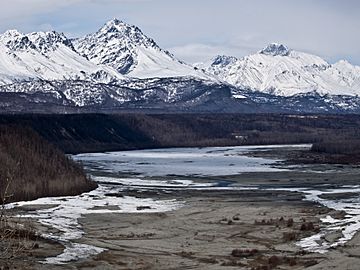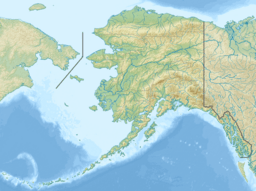Granite Peak (Matanuska-Susitna, Alaska) facts for kids
Quick facts for kids Granite Peak |
|
|---|---|

Southwest aspect, from Palmer area
(Lava Mountain to right) |
|
| Highest point | |
| Elevation | 6,729 ft (2,051 m) |
| Prominence | 1,529 ft (466 m) |
| Isolation | 5.69 mi (9.16 km) |
| Geography | |
| Location | Matanuska-Susitna Borough Alaska, United States |
| Parent range | Talkeetna Mountains |
| Topo map | USGS Anchorage D-6 |
| Climbing | |
| Easiest route | Scrambling |
Granite Peak is a cool mountain in Alaska, standing tall at about 6,729 feet (2,051 meters) above sea level. It's located about 16 miles (26 km) northeast of a town called Palmer, right in the southern part of the Talkeetna Mountains. This mountain is a famous landmark in the Matanuska Valley, sitting between Palmer and Chickaloon.
You can easily spot Granite Peak if you're driving on the Glenn Highway, which runs along the mountain's southern side. It's also about 6 miles (10 km) north of Sutton and 13 miles (21 km) north of Matanuska Peak. The name "Granite Peak" was first used in 1946 by the U.S. Geological Survey and made official that same year. In the Ahtna language, which is spoken by some Native Alaskans, this mountain is called Hdighilen Dghilaaye'.
Weather at Granite Peak
Granite Peak is in a subarctic climate zone. This means it has very long, cold, and snowy winters. The summers, however, are usually mild and pleasant.
Winter Conditions
During the winter, temperatures can drop really low, sometimes even below -20 °C (-4 °F). With the wind chill, it can feel even colder, possibly below -30 °C (-22 °F)! So, if you ever visit in winter, you'd need to bundle up!
Best Time to Visit
The best time to visit Granite Peak for climbing or just enjoying the views is usually from May through June. The weather during these months is much nicer and more comfortable.
Water Flow
Rain and melting snow from the mountain flow into two creeks: Eska Creek and Granite Creek. Both of these creeks eventually join the larger Matanuska River. This is how the water from the mountain makes its way to bigger bodies of water.


